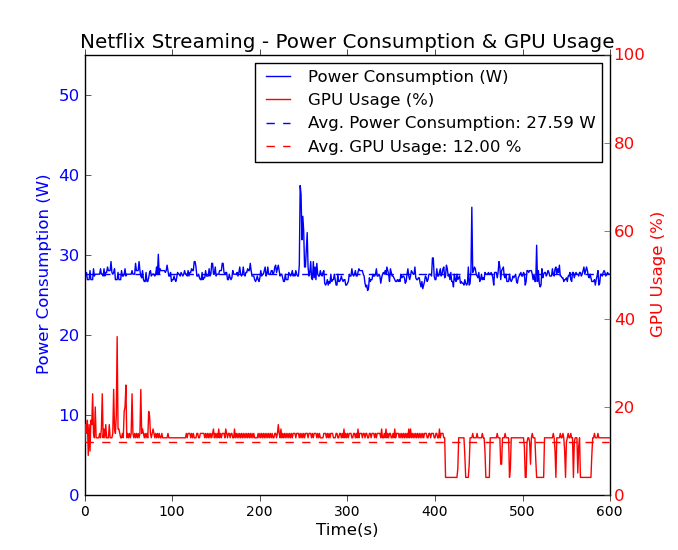Intel's Haswell - An HTPC Perspective: Media Playback, 4K and QuickSync Evaluated
by Ganesh T S on June 2, 2013 8:15 PM ESTNetwork Streaming Performance - Netflix and YouTube
The move from Windows 7 to Windows 8 as our platform of choice for HTPCs has made Silverlight unnecessary. The Netflix app on Windows 8 supports high definition streams (up to a bit rate of 3.85 Mbps for all ISPs, more if the ISP is Super HD enabled) as well as 5.1-channel Dolby Digital Plus audio on selected titles.
It is not immediately evident whether GPU acceleration is available or not from the OSD messages. However, GPU-Z reported an average GPU utilization of 12% throughout the time that the Netflix app was playing back video. The average power consumption is around 28 W.

Unlike Silverlight, Adobe Flash continues to maintain some relevance right now. YouTube continues to use Adobe Flash to serve FLV (at SD resolutions) and MP4 (at both SD and HD resolutions) streams. YouTube's debug OSD indicates whether hardware acceleration is being used or not.
Windows 8 has plenty of YouTube apps. We chose the Megatube YouTube Player / Downloader which allows for stream selection. For our power measurement experiments, we chose the 1080p MP4 stream.
However, we can't be sure whether hardware acceleration is being used with the app, as there is no debug OSD. However, a look at the power consumption numbers reveal that both approaches consume less than 30 W on an average. The difference in the caching of the stream is also visible in this graph, with the Flash approach preferring to download data in bursts while the app prefers to download the whole stream as quickly as possible. Streaming was done over Wi-Fi.

Comparing these numbers with what was obtained using the i3-3225 in a passive build shows that the Haswell build manages to be more efficient even when active cooling (with one big Antec Skeleton chassis fan and a CPU fan) is employed.
On the image quality front, Haswell doesn't seem to change anything here vs. Ivy Bridge. Performance was acceptable before, and it continues to be so here. The big difference is really the additional power savings.













95 Comments
View All Comments
jhoff80 - Sunday, June 2, 2013 - link
This article and the power consumption stats just make me wish that Intel would just make it easier to get a hold of their -T chips for end users. A 35W or 45W chip would be great for me, but the only thing that has full retail availability is the 65W one. (And it's not because it's so early in launch, it's always been way too difficult to get -T versions.)EnzoFX - Sunday, June 2, 2013 - link
Not to mention expensive! You get the same results by undervolting/underclocking, typically.Laststop311 - Monday, June 3, 2013 - link
You are correct in a way but you could undervolt the T series as well and get better thermal performance then the 65 watt version. atleast that is my experience. If i was making an HTPC i would use the i7-4770t or the i7-4650t if thats the equivalent of the i7-3770t this year. The power consumption is amazing and proper 24hz is great for 1080p24 playback. upgrade to the htpc just isn't in my budget right now and ivy bridge + gt 660 isnt a bad htpc. MY PC budget is going to an ultrabook upgrade this year. The increased battery life and performance is insane. i7-980x desktop still does not have a large enough upgrade to make it worth it. Ivy bridge-E is not THAT much faster and I dont think even haswell-e next year will be enough to upgrade the desktop.Death666Angel - Tuesday, June 4, 2013 - link
"but you could undervolt the T series as well and get better thermal performance then the 65 watt version."Not to the same extent. The T series will already be driving much tighter voltages than normal SKUs. While you may save 15% power consumption by undervolting normal SKUs, undervolting already power efficient SKUs would result in sub 5% probably.
vnangia - Sunday, June 2, 2013 - link
Well, it helps that there are 35W parts this time around - at least on the timeline. IVB didn't get any 35W parts, so the HTPC is still on SNB, and yeah, I could definitely use the incremental improvements to QuickSync.jhoff80 - Sunday, June 2, 2013 - link
Yes, but I'm not talking about only 35W specific chips. The i7-3770T was just as difficult to get as any other -T series chip, because they don't sell them to end-users directly.vnangia - Sunday, June 2, 2013 - link
I'm agreeing with you! What I was trying to say is, Intel did announce low-TDP SNB parts and delivered: SNB had a bunch of -T versions available to end-users at both low (G4xx, G5xxT, 2100T, 2120T) and high end (2390, 2500T). I bought my 2100T at Microcenter B&M for instance.By contrast, Intel didn't announce any end-user -T (and just a handful of -S) parts and we saw that IVB had virtually no -T parts available. I'm optimistic that now they've announced a few -T parts at the high end, we might actually see these materialize in the retail chain and hopefully it bodes well for -T parts at the low end.
Fortunately (*knocks on wood*) the current SNB-based HTPC is still going strong, so I don't feel the need to upgrade. If and when I do, though, I expect that it won't be so clear cut - I may end up going with AMD's lineup, despite the relative paucity of AMD ITX boards.
jhoff80 - Monday, June 3, 2013 - link
Sorry, I must've misunderstood.Krysto - Monday, June 3, 2013 - link
This is insane. Why use a $400 Intel Haswell media box for 4k video, when you can use the much cheaper and much more efficient Mali T622-based media boxes that should be appearing next year?http://blogs.arm.com/multimedia/977-a-new-branch-f...
NirXY - Monday, June 3, 2013 - link
"should be appearing next year"